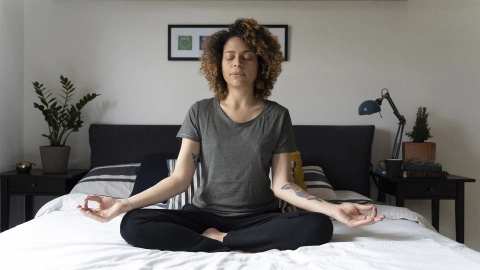Healthy living Healthy through exercise – every step counts
Exercise plays an important role in a healthy lifestyle. People who are physically active on a regular basis boost their immune system, avoid many illnesses and increase their sense of well-being. All types of movement count.
At a glance
- People who exercise regularly can prevent a range of illnesses and also help their bodies to fight existing illnesses.
- When we move, our muscles, heart and immune system are stimulated and our sense of well-being and quality of life are improved.
- Exercise can relieve stress and tension. It has a positive effect on both the body and mind.
- Even simple activities like walking up the stairs and taking regular walks contribute to improved health.
- Getting enough exercise is very important for children, as it promotes physical, social and cognitive development.
Note: The information in this article cannot and should not replace a medical consultation and must not be used for self-diagnosis or treatment.

Why is exercise important for health?
Most adults spend the bulk of their time sitting – whether at a desk, on a sofa or in a car. This is one reason the body doesn’t get enough physical activity and is at risk of health impairments and widespread health conditions such as type 2 diabetes and obesity.
On the other hand, those who are physically active can prevent many diseases, while also increasing their productivity and well-being. Regular exercise can also increase life expectancy. There are countless simple ways to become more active. Simply taking regular walks has a positive impact. Short distances, such as the route to work or to the grocery store, can also be covered by bike.
What effect does exercise have on the body?
Exercise is beneficial on many levels. It is not only the muscles, joints and entire musculoskeletal system that are strengthened. The immune system and metabolism are also stimulated and the heart and circulatory system are given a workout. Exercise also has a positive effect on mental health, as physical activity and sports lift the mood and can help with relaxation. Physical activity also prevents back pain.
Even in the short-term, exercise has many benefits for both body and mind – it reduces stress, promotes relaxation and improves sleep.
However, physical activity can also have long-term benefits for well-being, productivity and health. For example, exercise reduces the risk of type 2 diabetes and cardiovascular diseases.
Exercise can reduce or even eliminate the need for medication in the case of certain health conditions. However, it is essential to discuss this with a doctor in advance.
How much exercise is beneficial?
There’s no fixed formula but there is a framework that can be used as a guide.
Experts recommend doing moderately strenuous endurance activities for at least 10 minutes at a time. Breathing and heart rates should be increased during these activities. Examples include cycling, jogging, football and swimming.
It’s also important to train the muscles so as to strengthen the musculoskeletal system, joints, bones, tendons and ligaments. Examples of activities that do this include strength training, pilates and yoga.
However, any physical activity or sport is suitable in order to get moving more and to support physical fitness. The most important thing is that it should be enjoyable.
Different types of sport train motor skills – such as endurance, strength, speed, flexibility and coordination – in different ways. For example, jogging promotes endurance, while badminton improves coordination, speed and endurance in equal measure. Pilates mainly improves strength and flexibility, while climbing improves strength and coordination.
According to the “National Recommendations for Exercise and Promotion of Physical Activity”, the following guidelines apply to different age groups:
Babies and toddlers up to 3 years of age
It is important for babies and toddlers aged up to 3 years to be able to follow their natural desire for physical activity. Running around and playing are important for healthy growth and development. It is recommended that small children not be allowed to use any media such as TV, computers or smartphones.
Pre-schoolers
Children of pre-school/kindergarten age (aged 4–6 years) should only sit for short periods and should be physically active for at least 180 minutes every day. Parents should limit screen time to 30 minutes per day for this age group.
School-age children and adolescents
Children of primary/elementary school age and adolescents should do at least 90 minutes of moderate to intensive exercise a day – which can include up to 60 minutes of cycling or walking. In addition, strengthening the muscles several times a week is useful to build strength and endurance. Elementary school children should not sit in front of a screen any longer than 60 minutes per day, while adolescents should not spend more than 120 minutes in front of a screen.
Adults
For adults up to age 65, a weekly total of 150 minutes of moderately strenuous exercise, preferably with a focus on endurance – or alternatively 75 minutes of strenuous physical activity – is recommended. These include strengthening exercises like gymnastics or weight training 2 days a week. Older people with reduced mobility should also do balancing exercises to reduce their risk of having falls.
People with a chronic illness
Adults up to the age of 65 with a chronic illness such as type 2 diabetes, chronic obstructive pulmonary disease (COPD), osteoarthritis or depression, should follow the exercise guidelines for adults without a chronic illness. In phases during which their illness doesn’t allow them to exercise to the extent that is recommended, they should be as active as their situation allows. It is recommended that they discuss physical training programs in advance with the doctor treating them.
Read the article Diet and exercise in later life to find out how much exercise and which types of exercise are recommended for people aged 65 and over.
Sitting
For all age groups, sitting for long periods of time should be avoided as much as possible. Prolonged sitting increases the risk of developing chronic health conditions, such as type 2 diabetes, obesity and cardiovascular diseases.
The average life expectancy of people who often sit for prolonged periods is also shorter than for those who spend less time sitting down. Prolonged sitting can be broken up with several short movement breaks – for example, going for a walk or cycle or climbing the stairs.
Video How much exercise is healthy?
Watch this video to find out what type and intensity of physical activity is considered good for your health.
How can exercise be incorporated into daily work routines?
In the workplace, health problems are often triggered or exacerbated by stress, time pressure and a lack of physical activity. For example, tension and back pain are produced by the hectic pace and few breaks, but also due to sitting for too long and in an improper manner.
Even small changes can have a big impact by helping to prevent stress and health issues and to promote health in the workplace:
- More physical activity in the workplace can be achieved by taking a few simple steps – such as visiting colleagues in person instead of calling them on the phone.
- It is also possible to stretch regularly or move the feet up and down. Deep abdominal breathing also helps.
- Neck and shoulder exercises can easily be done at a desk.
- It’s healthy to eat lunch in peace and quiet, eating slowly and enjoying your food, followed by a short stroll to help with digestion.
- It’s important to sit “correctly” in order to rest the back – a good, properly adjusted office chair, a standing desk or a balance cushion can be very beneficial. The most important thing, however, is to avoid sitting in the same position for too long.
The German Pension Insurance Organization (“Deutsche Rentenversicherung”) offers a free preventive program for employees who are already experiencing some minor aches and pains (in their backs, for example). It promotes exercise, healthy eating and teaches effective ways to handle stress. All the information you need about the RV program is available at rv-fit.de.
Health insurance providers also fund preventive training courses in the areas of exercise, relaxation and the use of addictive substances. Ask your health insurance provider for information about which courses are on offer in your region and whether you may be entitled to funding to attend.
How can people get more exercise on a daily basis?
It’s not a good idea to sign up for a marathon with a view to transforming from a couch potato into an elite athlete overnight. It’s better to have realistic goals that are not set too high in order to keep integrating exercise and sport into daily life on a permanent basis.
Walking a few steps more each day is a good way to discover the joy of exercise slowly without overdoing it. Initially, a lot can be achieved by simply getting off at an earlier stop on the way to work and walking part of the way on foot, taking a bike more often and using the stairs rather than the elevator.
Interesting fact: Many health insurance providers now offer exercise instructions and videos on their websites. This makes it very simple and straightforward to exercise at home. For many exercises, no extra equipment is required.
Larger-scale physical activities should ideally be done with a partner. Long walks and hikes with the family or jogging, swimming and yoga with friends are more fun than going it alone.
It’s also important for every individual to find the type of sport that suits them. Along the way, feel free to try out a few and if necessary, seek advice from a doctor or trainer.
Important: Anyone aiming to live a healthier life overall and avoid illness should also ensure that they eat a balanced diet. The article Healthy eating provides tips for success in this area.
For children, it’s important to support the natural desire for physical activity from the outset – for instance, by encouraging free play at home, in the playground or at the park, by going on outings, hikes and cycles together or by letting them try out different types of activity in sports clubs. This promotes physical and cognitive development, as well as enjoyment of exercise.
People who are very active as children and adolescents will also find it easier later on to incorporate regular activity into their daily routine. Children also train their perceptive capabilities when playing sport and running around and learn how to better assess their own abilities and limits. Active children usually also concentrate better, which makes it easier for them to learn.
- Bundesanstalt für Landwirtschaft und Ernährung. Bewegung kann Medikamente ersetzen. inform.de Aufgerufen am 18.02.2022.
- Bundesanstalt für Landwirtschaft und Ernährung. Klettern, Bolzen, Toben. inform.de. Aufgerufen am 18.02.2022.
- Bundesministerium für Gesundheit. Ratgeber zur Prävention und Gesundheitsförderung. 9. aktualisierte Auflage. 01.2016.
- Bundeszentrale für gesundheitliche Aufklärung (BZgA). Menschen in Bewegung bringen – Strukturen schaffen, Bewegung fördern, lebenslang bewegen. 03.2019.
- Finger JD, Mensink GBM, Lange C, Manz K. Gesundheitsfördernde körperliche Aktivität in der Freizeit bei Erwachsenen in Deutschland. Journal of Health Monitoring 2017. 2(2): 37-44.
- Rütten A, Pfeiffer K. Nationale Empfehlungen für Bewegung und Bewegungsförderung. FAU Erlangen-Nürnberg 2016.
- Weltgesundheitsorganisation (WHO). Global action plan on physical activity 2018-2030: more active people for a healthier world. 2018.






